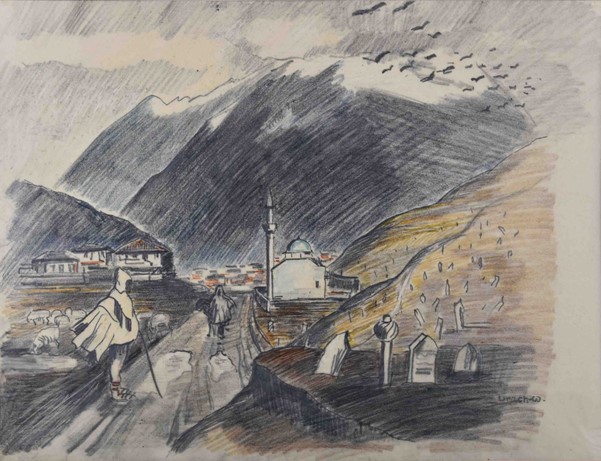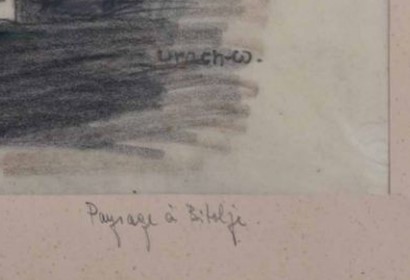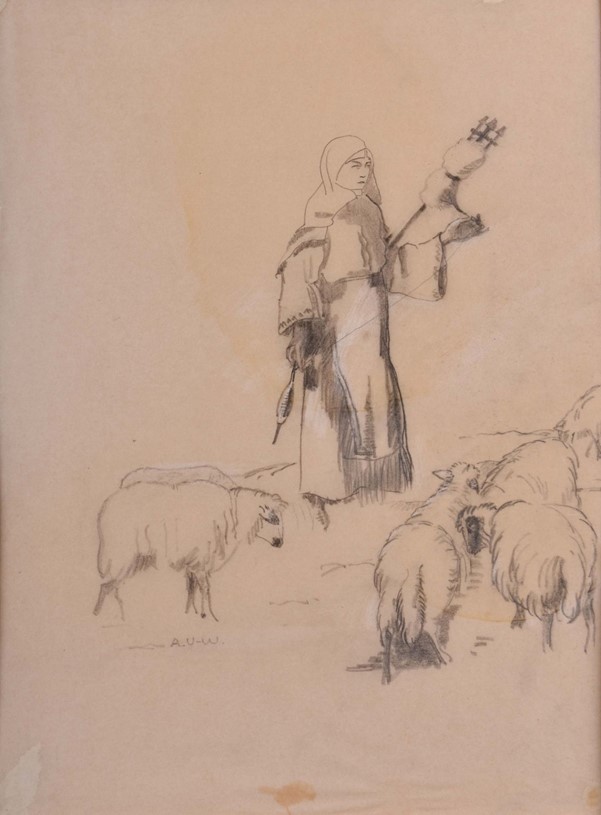Prince Albrecht of Urach (German: Fürst Albrecht von Urach, Graf von Württemberg) (18 October 1903 – 11 December 1969) was a German nobleman, artist and wartime author, journalist, linguist and diplomat1). He was the third son of Wilhelm Karl, Duke of Urach (1864-1928), a German general in the First World War who was briefly chosen as king of Lithuania. His mother was Amalie (1865-1912), daughter of Karl-Theodor, Duke in Bavaria and a niece of Empress Elisabeth of Austria. Amalie’s sister was the Queen of the Belgians. They lived in Stuttgart and at Lichtenstein Castle, and paid frequent visits to Monaco before 1914. His father’s mother was Princess Florestine of Monaco (1833–98), and so he was named after her nephew Prince Albert I of Monaco. The von Urach Family were supposed to be successors of the throne of Monaco, but France preferred French succession of Monaco. In later life in the 1930, Albrecht von Urach unsuccessfully tried to persuade French Foreign Office to accept him as a legitimate heir of the Monaco throune.
Following the German defeat in 1918, Albrecht studied art in Stuttgart under Arnold Waldschmidt and Christian Landenberger, and then in Paris at the Académie de la Grande Chaumière in 1927-30, developing an expressionist style. He then exhibited in 1930-32 at the Leicester and Redfern galleries in London, Galerie Bonaparte in Paris and at Blomquist in Oslo, but could not make a living from painting with the start of the Great Depression, and took up freelance photography. His artistic friends included Willi Baumeister and Fernand Léger. His artistic output resumed in the 1950s.
In April 1934 he was living in Venice, and by chance photographed the first unpublicized meeting of Mussolini and Hitler, which was followed by a public rally in the Piazza San Marco. Albrecht turned this scoop into a permanent position as a journalist based in Tokyo from September 1934, covering the Chinese-Japanese war. To become a journalist, he was required to join the Nazi party in 1934. In early 1939 he returned to Europe and was posted to Rome as the Foreign Office liaison between the German and Italian Press
In the period 1940-1943 he was seen by the Nazi party as an expert of Far East and to secret missions in Asia, monitoring Japan’s progress in the war. When the war fortune turned its back to Nazi’s, he was desperate to leave Germany. In early 1944 he succeeded in get an appointment as press attaché at the German Embassy in Berne, In May 1945, as the Embassy no longer represented a state, all the German Embassy staff was expelled to the French-controlled part of Germany, and he was interned for questioning until 1946. In 1946-48 von Urach was charged by a German court for creating and broadcasting propaganda in the National-Socialist style, and for membership of the Nazi party. He apologized and there was no sanction whike his superiors were prosecuted in the Ministries Trial in 1948. In 1947-67 he resumed his career as an artist and freelance journalist.
He was appointed chief press attaché at Mercedes Benz in Stuttgart in 1953-67, where his elder brother Wilhelm was a director. This suited his ability in languages, and he travelled widely. He is jointly credited with encouraging the design of the Mercedes-Benz 300 SL.
As a painter, in the period 1933/1934 Albrecht vor Urach travelled through Albania, Yugoslavia and Bulgaria2) where he produced series of pencil and crayon drawings. Few of these drawings were made in Bitola and sold by auction house Kloss3) , on May 5th 2021,
- Information taken from Wikipedia: https://en.wikipedia.org/wiki/Albrecht_von_Urach
- Information taken from Personal Affairs of Royal House, State Archive of Baden-Württemberg, Abt. Hauptstaatsarchiv Stuttgart (https://www.archivportal-d.de/item/EJ3Z75MU7QF7E2FVEWUDH3QMRF7ELZ53?isThumbnailFiltered=false&rows=20&offset=0&viewType=list&hitNumber=7)
Lot number 698 “Monastir in Mazedonien” ( this is the official name of the painting in the auction catalogue, but the drawig itself was titeld in pencil in French language “Paysage a Bitolj” (https://auktionen.auktionshaus-kloss.de/de/l/27467/albert_fuerst_von_urach_1903-1969_albert_fuerst_von_urach_1903-1969?Q=urach&Aid=47&Lstatus=0¤tpos=2), Lot number 703 “Shephard from Balkan” (https://auktionen.auktionshaus-kloss.de/de/l/27472/albert_fuerst_von_urach_1903-1969_albert_fuerst_von_urach_1903-1969?Q=urach&Aid=47&Lstatus=0¤tpos=7)


